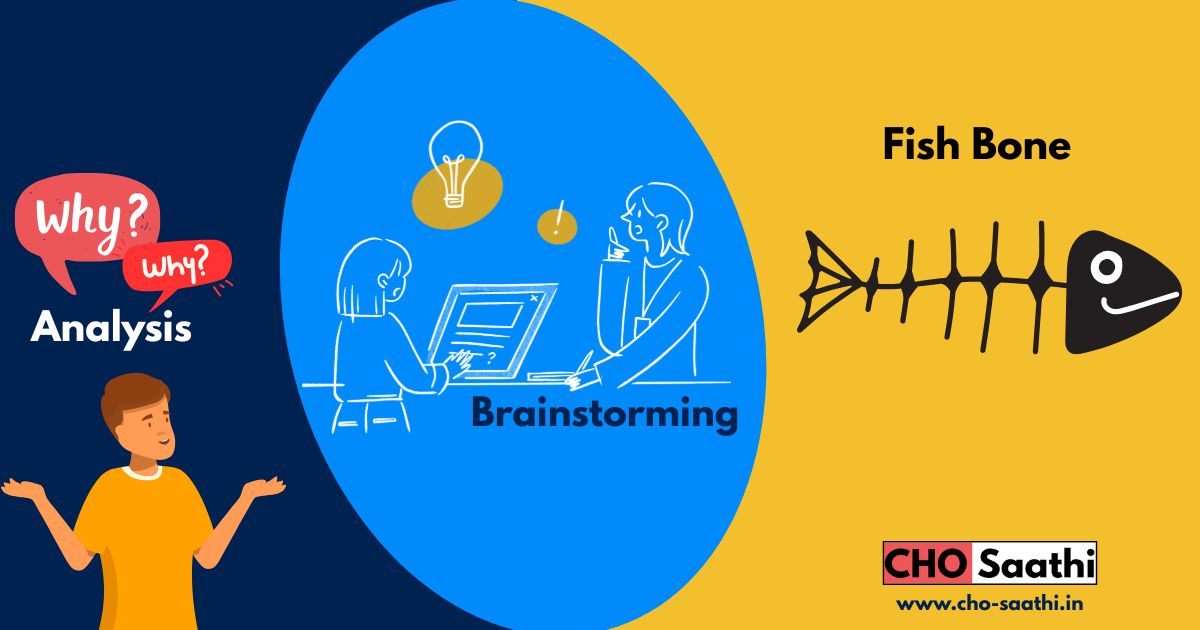Dear Community Health Officers (CHOs),
Preparing for NQAS Assessment might seem challenging, especially when it comes to using quality improvement tools. But don’t worry—this post will help you understand and create the three essential tools used during Gap Analysis and Quality Improvement Planning:
- Why-Why Analysis
- Brainstorming Sheet
- Fishbone Diagram
Let’s explore them one by one with simple examples and step-by-step formats.
1. WHY-WHY ANALYSIS TOOL
What is Why-Why Analysis?
Why-Why Analysis is a problem-solving technique used to find the root cause of an issue. It involves asking “Why?” repeatedly (usually 5 times) until the real underlying cause is identified.
This tool is very useful during NQAS assessments when you find a gap or non-compliance in any standard or checklist.
When to Use?
Use Why-Why Analysis when:
- There is a problem in documentation or process.
- You observe poor performance in any service area (like ANC, OPD, Immunization).
- You want to find and fix the real cause behind a recurring issue.
How to Do It?
Step-by-Step:
- Identify the problem clearly.
- Ask “Why?” and write the immediate cause.
- Take that answer, and again ask “Why?”—repeat 4–5 times.
- The final answer is usually the root cause.
- Plan an action to address the root cause.
Example:
Problem: Immunization register is not filled correctly.
| Step | Question | Answer |
|---|---|---|
| 1 | Why is the immunization register not filled correctly? | ANM missed entering details. |
| 2 | Why did ANM miss the details? | She was handling too many clients. |
| 3 | Why was she handling many clients alone? | No helper or assistant available. |
| 4 | Why is there no assistant available? | Support staff is not appointed or trained. |
| 5 | Why is there no proper staff planning? | Administrative support is lacking. |
Root Cause: Lack of support staff and poor planning.
Format for Why-Why Analysis:
You can write this tool on an A4 sheet or create a soft copy:
- Problem Statement:
- Why 1:
- Why 2:
- Why 3:
- Why 4:
- Why 5:
- Root Cause Identified:
- Action Plan to Solve the Issue:
- Date & Signature of CHO:
Keep a copy in your Quality Improvement (QI) file.
Also Read: Simple Guide to Create CAPA and PDCA for NQAS Assessment
2. BRAINSTORMING TOOL
What is Brainstorming?
Brainstorming is a team activity to generate multiple ideas or solutions for a particular problem. It encourages everyone’s participation and helps in decision-making and planning.
When to Use?
- When you need new ideas to solve a challenge.
- When teamwork is required to improve services.
- For QI projects and during monthly meetings.
How to Conduct a Brainstorming Session?
Step-by-Step:
- Identify a topic or problem area (e.g., Low OPD attendance).
- Call a short meeting with staff: CHO, ANM, MPW, ASHA.
- Ask each participant to share ideas without any criticism.
- Write all ideas on paper or whiteboard.
- Select the best and feasible ideas.
- Assign responsibility and create a simple action plan.
Example:
Topic: Low OPD Attendance at SHC
| Date | Topic | Participants | All Ideas Shared | Final Solutions |
|---|---|---|---|---|
| 12-07-2025 | Low OPD Attendance | CHO, ANM, ASHA, MPW | Conduct health camp, Door-to-door visits, Display posters, Local WhatsApp awareness | Monthly Health Camp, Display IEC at Panchayat Bhawan |
Save this in your NQAS QI documentation file with signatures of team members.
Format Template:
- Date of Meeting:
- Topic Discussed:
- Participants (Names):
- Ideas Collected:
- Selected Solutions for Action:
- Follow-up Plan:
- CHO Signature & Stamp:
3. FISHBONE DIAGRAM (Cause & Effect Tool)
What is a Fishbone Diagram?
The Fishbone Diagram (also called Ishikawa Diagram) is a tool that helps identify all possible causes of a problem. It looks like a fish skeleton, with the problem at the “head” and causes branching out like bones.
When to Use?
- To understand complex issues during gap analysis.
- During internal quality reviews.
- To visually explain a problem during presentations or assessments.
How to Make a Fishbone Diagram?
Step-by-Step:
- Draw a horizontal arrow. Write the main problem at the right end (head of the fish).
- Draw 4–5 diagonal lines (bones) connecting to the main line.
- Label the categories:
- Manpower
- Method (Process)
- Materials (Supplies)
- Equipment
- Environment
- Under each category, write possible causes.
Example:
Problem: Delay in ANC Services at SHC
mathematicaCopyEdit Manpower Method Material Equipment Environment
\ \ \ \ \
\ \ \ \ \
\ \ \ \ \
[Delay in ANC Services]
Manpower: ANM is often on field visits
Method: No appointment system
Material: Lack of ANC kits
Equipment: BP apparatus not working
Environment: Waiting area is uncomfortable
Once all causes are identified, plan corrective actions for each.
How to Present:
- Use A3 or chart paper for visibility.
- Clearly label the problem and categories.
- Use different colors for clarity (optional).
- Paste it on your Quality Wall/Corner.
BONUS: Tips to Get Full Marks in NQAS Using These Tools
- Always date and sign each tool.
- Keep tools updated in your QI documentation file.
- Involve all staff to show team participation.
- Link every problem to an action plan.
- Present these tools during NQAS internal or external assessments.
Final Words
Using these simple tools not only helps you improve your Sub-Health Center services but also shows your active efforts during NQAS assessment. Every CHO can create these tools with the help of their team using basic stationery or computer files.
Start practicing today and build a quality-focused culture in your Ayushman Arogya Mandir!
Discover more from CHO Saathi
Subscribe to get the latest posts sent to your email.



1 Comment